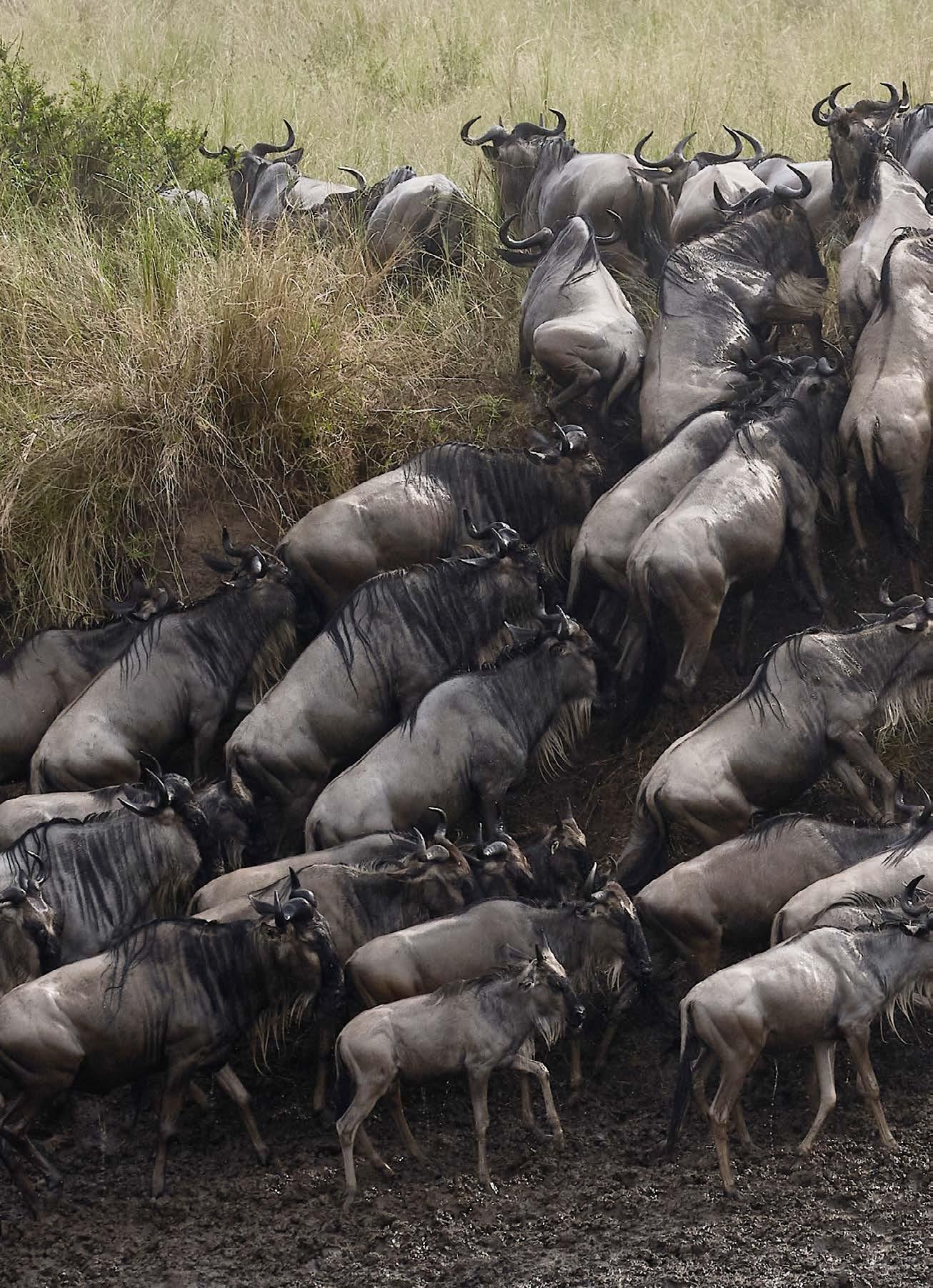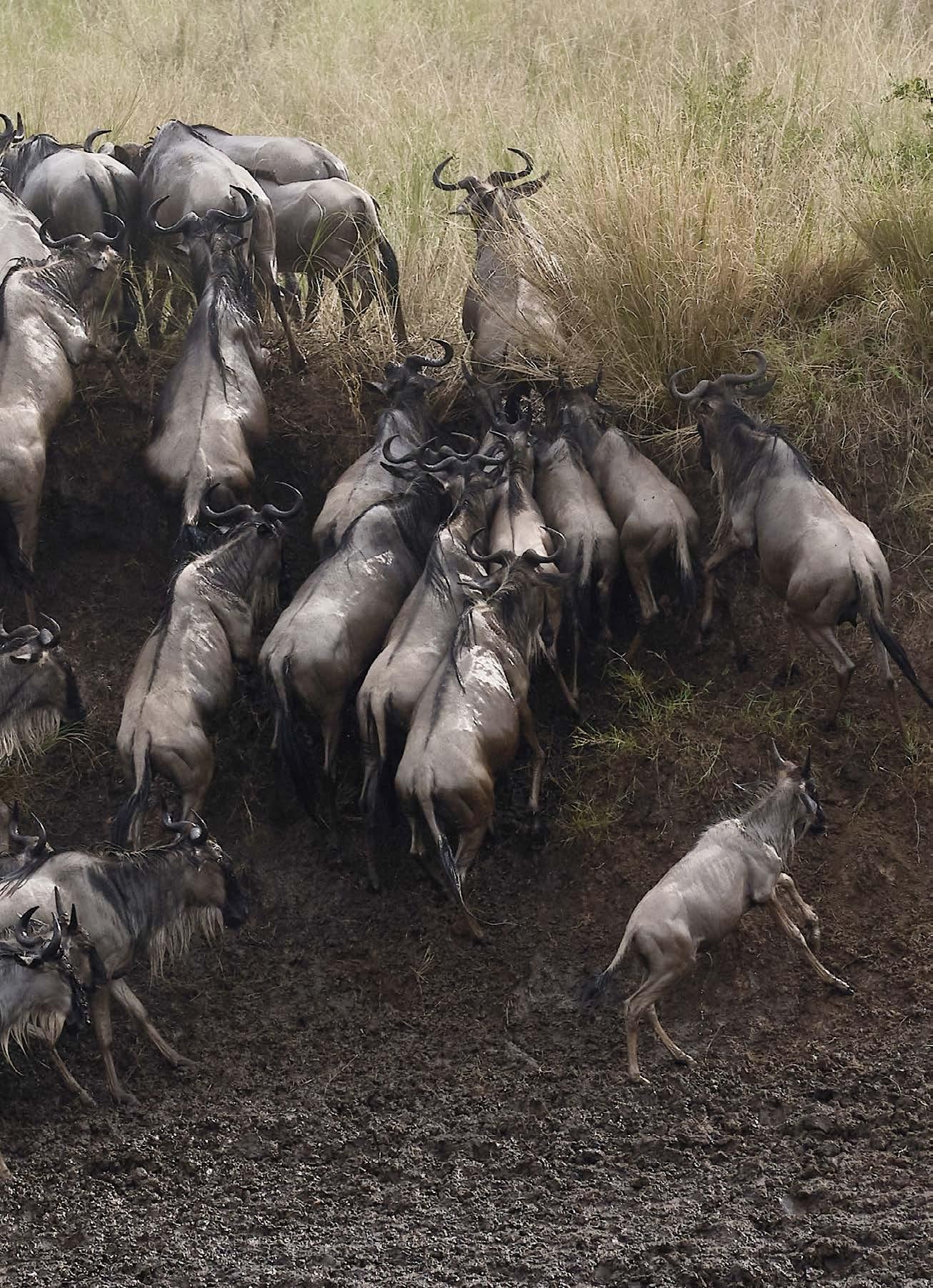
4 minute read
The Greatest Show on Earth
PHOTOGRAPHS: BRIAN SIAMBI
Advertisement

On the opposite banks of the Mara River, what may well be a thousand wildebeest cover the vicinity, ready to plunge 15 feet below to either greener pasture or death. Despite having visited Maasai Mara a couple of times, this is my first time witnessing the wildebeest migration, an event that runs from July to November each year with up to two million animals (mostly wildebeest, but also zebras and gazelle) moving in a clockwise direction across the ecosystems of the Serengeti and Mara to graze and calve. I am taken aback, too, by just how many cars there are- I reckon it’s about 300- all piled with eager tourists waiting to ambush with their cameras. I am under no illusion that I have unearthed this experience, and will certainly not be setting up any monuments or renaming the place after myself.
Prior to visiting, I had imagined a melee where millions of wildebeest storm across the river at once like some biblical exodus across the Red Sea, but they seem to cross in large herds several times throughout the day. Every day. It also takes a lot of patience waiting for them to actually cross as they like to linger, sometimes skittering about, only to backtrack; a process that seems quite confused to the novice human eye. Hippos lazily bask in the afternoon sun as crocodiles bob in and out of the water, eyeing the impending buffet. About 40 minutes later, a scout goes down the high rock interface and jumps into the water. Hot on his trail, a large swirl of dust gathers as the rest of the herd, in a loose column, hurl themselves Prior to visiting, I had into the water and half-swim, half-jump to the opposite side. They clamber out, nodding, bearded heads as clumsy as their gait. Some imagined a melee where run off, diminishing into the empty landscape, while others seem to mill about, beckoning to their peers. millions of wildebeest storm across the river at

Not everyone makes it though. After driving about a kilometre once like some biblical away, we watch as a lioness glides through the tall grass on padded paws with a graceful elegance and deadly concentration about her, exodus across the Red steely gaze zeroing in on a herd of wildebeest. Calculating. “Is it really going to attack?” someone animatedly whispers in the car. Sea, but they seem to But, a few seconds later, the lion slinks back into the savannah. A broken limb or exhaustion can make the wildebeest easy pickings for cross in large herds predators, as the half-eaten bodies around the park can attest. Other wildebeest also drown and their carcasses later float downstream to be teared apart by vulture talons, stinking up areas like the Mara several times throughout the day. bridge.
That evening, with hyenas whooping in the distance, we unwind around a bonfire as the lodge staff ply us with nuts, soft drinks and amusing stories. In the absence of a good glass of wine, given the government restrictions at the time, these post-game drive hangouts are just not as fun, and so I turn in early for the night. The day has been exhausting. We left Nairobi early in the morning and after a brief stop for lunch in Narok Town, arrived at Maasai Mara’s Sekenani gate only six hours later. If you had visited the Mara by road some two years back, you would have sworn never to do it again given the terrible state of the road, but having been tarmacked all the way to the gate, it is now more accessible than ever. Cocooned under canvas, I dream of elephants huddled around my apartment in Nairobi watching Blood & Water on Netflix.

One reason I’ve never seen the wildebeest migration before is that this time of the year is always peak season in the Mara, and prices are adjusted to reflect that. This year, with a lot of countries still on lockdown given the on-going pandemic, the focus has been on domestic travelers, and a lot of lodges have been offering competitive discounted rates to draw visitors. If you’ve never witnessed it, now would be the time to go.
The following morning we are off to the lookout point to see the crossing a second time. On the way we spot animals like zebras, but in this season of wildebeest, anything else is just supporting cast...unless you see a hunt, because that will always be epic. Elephants trumpet in the distance. Buffaloes are camouflaged into the hillside like black boulders. A warthog skips past, intent on warthog business. Wildebeest, too, are cantering across the dirt road in numbers that will never cease to amaze. Should there be a long wait today, I have some packed lunch ready...









